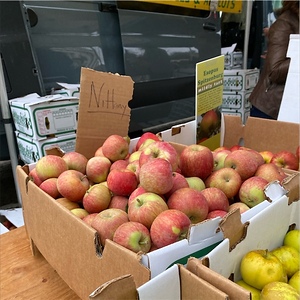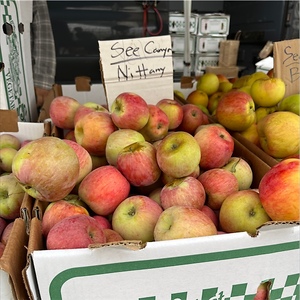


Nittany Apples
Estimated Inventory, lb : 0
Description/Taste
Nittany apples are a medium to large variety, averaging 7 to 8 centimeters in diameter, and have a conical, oblong, to slightly lopsided shape. The skin is smooth, firm, and semi-thick, covered in a layer of wax and the occasional russet. The skin also has a yellow-green to faintly orange base with large patches of dull red blush and striping. Underneath the surface, the pale-yellow to white flesh is firm, dense, and aqueous, showcasing a crisp, snap-like consistency. The flesh also encases a central core filled with black-brown seeds. Nittany apples have a sweet, moderately acidic flavor with nutmeg and additional warm spice undertones.
Seasons/Availability
Nittany apples are available in the fall through winter.
Current Facts
Nittany apples, botanically classified as Malus domestica, are a modern American cultivar belonging to the Rosaceae family. The large, firm-fleshed variety was released through the Fruit and Research Center of Pennsylvania State University in the 1970s and was selected for its extended storage capabilities, bright coloring, and balanced taste. Since their introduction, Nittany apples have primarily remained a boutique variety localized to the Northeastern United States. Nittany apples are favored for fresh eating and are also highly valued for their ability to hold their shape in a wide array of cooked applications.
Nutritional Value
Nittany apples are a good source of vitamins A and C, nutrients with antioxidant-like properties to strengthen the immune system, repair cell damage, increase collagen production, and reduce inflammation. The fruits are also a source of fiber to regulate the digestive tract and contain smaller amounts of potassium to balance fluid levels within the body, calcium to protect bones and teeth, and iron.
Applications
Nittany apples have a firm flesh with a sweet, subtly tart flavor well suited for fresh and cooked preparations. The apple’s flesh also oxidizes slowly, allowing slices of the fruit to be tossed raw into green salads, fruit salads, yogurt, granola, and grain bowls. Nittany apples can also be blended into smoothies, juiced and mixed into sparkling beverages and cocktails, or pressed into ciders, retaining a pleasant, golden tone. In addition to fresh preparations, Nittany apples retain their shape when cooked, lending themselves well to several baked preparations. Nittany apples can be stuffed, baked into dumplings, or incorporated into tarts, muffins, bread, and pies. The fruits can also be cooked and pureed into applesauce and apple butter or used to flavor ice cream. Nittany apples pair well with herbs such as rosemary, basil, mint, and lavender, fruits including oranges, other citrus, bananas, and mangoes, nuts such as walnuts, almonds, pecans, and pistachios, and spices such as cinnamon, nutmeg, and cloves. Whole, unwashed Nittany apples bear a layer of wax that allows the fruit to stay fresh for a couple of months when stored in a plastic bag in the crisper drawer of the refrigerator.
Ethnic/Cultural Info
Nittany apples are named after the Nittany Lion, the Penn State University mascot. The name Nittany is derived from a Native American word meaning “single mountain,” and the well-known Nittany Mountain is located in Central Pennsylvania. The Penn State University campus also resides at the base of the mountain. Legend has it that the Nittany Lion mascot was inspired by an ancient mountain lion species that is now extinct but used to roam across the Nittany Mountain. In 1904, Penn State student Harrison “Joe” Mason was playing for the Penn State baseball team at Princeton University when he decided to name the Nittany Lion as Penn State’s mascot. At the time, Penn State did not have a formal mascot, and during the baseball game, Mason noticed Princeton’s tiger mascot and wanted to match the ferocity of a tiger, so he decided upon a mountain lion. Penn State defeated Princeton in the baseball game, and the Nittany Lion quickly grew in popularity among Penn State students. Through additional promotion and publication of the new mascot, the Nittany lion eventually became the Penn State school mascot without an official vote. In 1942, a Nittany Lion Shrine was also built in the park campus at Penn State, cementing it as the permanent mascot.
Geography/History
Nittany apples were discovered as an open-pollinated seedling by a scientist in West Virginia and were sent to Pennsylvania State University’s Fruit Research and Extension Center in Biglerville, Pennsylvania, for further study. The variety was planted in the extension center’s 55-acre orchard and is a cross between the golden delicious and york imperial apple, a famous cultivar in Pennsylvania. Nittany apples were successfully produced in the 1970s and were released to local growers for commercial cultivation. Today, Nittany apples are a favorite local variety in the Northeastern United States, but the variety is relatively unknown outside of that region. When in season, Nittany apples can be found through specialty growers, distributors, and farmer’s markets.
Recipe Ideas
Recipes that include Nittany Apples. One
| Sally's Baking Addiction |
|
Baked Apples |
| Inspired Taste |
|
Apple Pie |
| Ciao Chow Linda |
|
Upside Down Apple Cake |
| Minimalist Baker |
|
Cinnamon Baked Apples |









